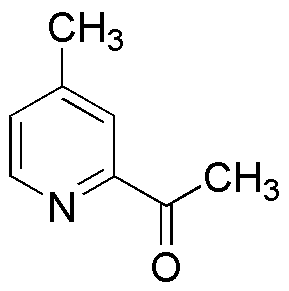2-Acetyl-4-methylpyridine is widely utilized in research focused on:
- Flavoring and Fragrance Industry: This compound is often used as a flavoring agent in food products and as a fragrance in perfumes due to its unique aromatic profile, enhancing sensory experiences.
- Pharmaceuticals: It serves as an important intermediate in the synthesis of various pharmaceuticals, contributing to the development of new medications with improved efficacy.
- Agricultural Chemicals: The compound is utilized in the formulation of agrochemicals, offering potential benefits in pest control and crop protection, thereby supporting sustainable agriculture.
- Research and Development: In academic and industrial research, it is used as a building block for synthesizing complex organic molecules, aiding in the discovery of new compounds with desirable properties.
- Analytical Chemistry: It is employed in analytical methods for detecting and quantifying specific substances, providing valuable data for quality control in various industries.
General Information
Properties
Safety and Regulations
Applications
2-Acetyl-4-methylpyridine is widely utilized in research focused on:
- Flavoring and Fragrance Industry: This compound is often used as a flavoring agent in food products and as a fragrance in perfumes due to its unique aromatic profile, enhancing sensory experiences.
- Pharmaceuticals: It serves as an important intermediate in the synthesis of various pharmaceuticals, contributing to the development of new medications with improved efficacy.
- Agricultural Chemicals: The compound is utilized in the formulation of agrochemicals, offering potential benefits in pest control and crop protection, thereby supporting sustainable agriculture.
- Research and Development: In academic and industrial research, it is used as a building block for synthesizing complex organic molecules, aiding in the discovery of new compounds with desirable properties.
- Analytical Chemistry: It is employed in analytical methods for detecting and quantifying specific substances, providing valuable data for quality control in various industries.
Documents
Safety Data Sheets (SDS)
The SDS provides comprehensive safety information on handling, storage, and disposal of the product.
Product Specification (PS)
The PS provides a comprehensive breakdown of the product’s properties, including chemical composition, physical state, purity, and storage requirements. It also details acceptable quality ranges and the product's intended applications.
Certificates of Analysis (COA)
Search for Certificates of Analysis (COA) by entering the products Lot Number. Lot and Batch Numbers can be found on a product’s label following the words ‘Lot’ or ‘Batch’.
Numéro de catalogue
Numéro de lot/série
Certificates Of Origin (COO)
This COO confirms the country where the product was manufactured, and also details the materials and components used in it and whether it is derived from natural, synthetic, or other specific sources. This certificate may be required for customs, trade, and regulatory compliance.
Numéro de catalogue
Numéro de lot/série
Safety Data Sheets (SDS)
The SDS provides comprehensive safety information on handling, storage, and disposal of the product.
DownloadProduct Specification (PS)
The PS provides a comprehensive breakdown of the product’s properties, including chemical composition, physical state, purity, and storage requirements. It also details acceptable quality ranges and the product's intended applications.
DownloadCertificates of Analysis (COA)
Search for Certificates of Analysis (COA) by entering the products Lot Number. Lot and Batch Numbers can be found on a product’s label following the words ‘Lot’ or ‘Batch’.
Numéro de catalogue
Numéro de lot/série
Certificates Of Origin (COO)
This COO confirms the country where the product was manufactured, and also details the materials and components used in it and whether it is derived from natural, synthetic, or other specific sources. This certificate may be required for customs, trade, and regulatory compliance.


